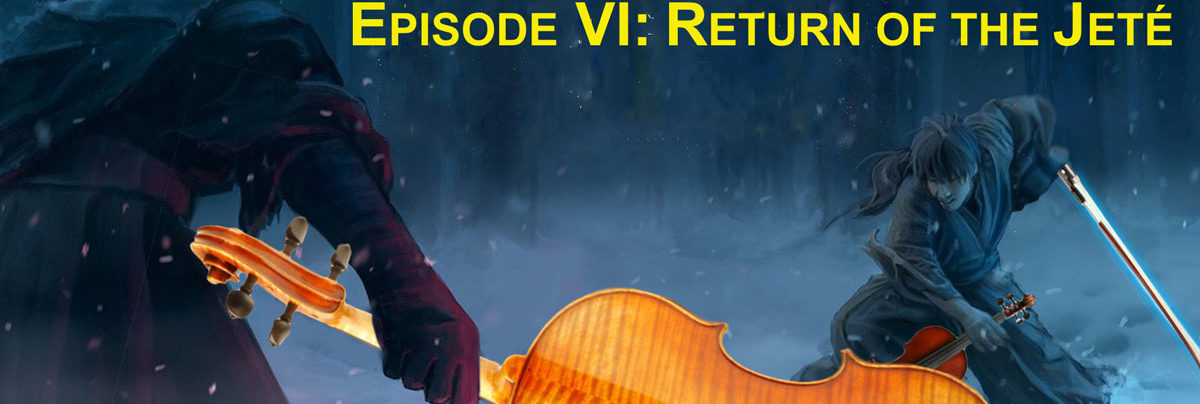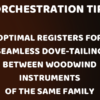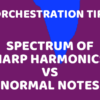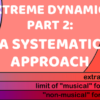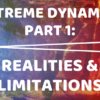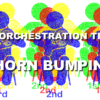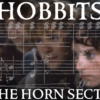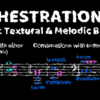A lot of people, including fairly-well trained musicians, don’t understand John Williams’ approach – or perhaps it would be better to say that they think they do, and typify their misconceptions with a clichéd interpretation of what his music sounds like. And that’s because so few people know how to really listen to what’s going on in that music. They focus only on the moments that are easy to remember, and then claim that those are the bulk of the soundtrack. A critic and filmmaker whom I’ve worked with in the past reviewed The Force Awakens this week, claiming that John Williams “…only coughs up one good new theme in this film, with the rest being largely filler.”
Do you see what’s happening here? With all respect to my dear colleague (whose judgement I can’t vigorously fault, seeing as how he once hired me as a film composer), these reactions are similar to eating a 7-course dinner and only remembering the dessert. There is so much more to the film, and it doesn’t take the ears of an orchestrator to hear that.
In these reviews, we’ve largely focused on the brass, along with comments about how new themes and contexts were needed to revitalise film history’s most successful franchise. About winds and percussion there isn’t an enormous amount I can say, as in Star Wars soundtracks these sections are largely used as spice, coloration, propulsion, and the occasional solo. It would still be interesting to dissect certain features in the future, however sparse. Moving on for today, that leaves the strings, a huge topic which I’ll attempt to mostly cover in one extra-long post.
Picking up from my opening thesis, a common stereotyping about Star Wars soundtrack strings is that they “play soaring melodies and backup chords, and that’s about it” (as I once heard another colleague say). But no, that’s not “it” by a long shot. There’s a reason why experienced film composers and orchestrators initially hailed Williams’s breakthrough 1977 Star Wars score as “symphonic.” It’s more than simply “orchestral.” The word “symphony” has the literal root definition of “sounds together.” In context with the symphonic form’s Classical Era development, this meaning came to be understood as music performed as a discourse between ever-expanding groups of instruments, a mirror of the ongoing cultural conversation. As society became ever more complex and diverse, so did the symphony, until it strained the ability of listeners to comprehend on one listening, as in the symphonies of Bruckner, Mahler, and Richard Strauss.
So in these truly symphonic scores by Williams, the instruments do more than just respond apishly to the onscreen action and dialogue. Instead, they converse with one another about the meaning of the emotional arcs and ongoing story. They don’t brutally tell the audience how to feel, but sensitively explore the deeper motives and reactions of the characters. They inform sweeping landscapes, and set the pacing for the film’s tempo better than any series of edits or flailing stunt men. The footage becomes a part of the expression of the symphonic tale, a visual listener’s guide to something with deep musical roots.
One feature of nearly every successful symphony is that strings are the most prominent, most active section in the orchestra. They’re tireless and infinitely flexible in tone and approach, and they don’t wear out the listener’s ear or patience like the other sections. To know how to orchestrate is to fundamentally know how to base your sound on strings. To compose symphonically is to use those strings for everything: moderating opposing moods and timbres, introducing (and subverting) themes, supporting action and drama, infusing passages with light, energy, and colour, and a thousand other things.
It takes a certain personality to be a successful string player for cuing sessions, and I’ve known quite a few, particularly those in the Skywalker Orchestra. You need a cool head, non-judgemental of the many absurd and barely-playable parts that come your way – and talent to burn. Without that, session work is gruelling rather than an exciting challenge. As we go through the following tracks, think of those talented, dedicated session players and what they’re bringing to the music. Most of them are amazing people, and my music has directly benefited from the generosity and support of players just like them.
Let’s discuss John Williams’ general approach to Star Wars string scoring (but remember that on other projects and film series, he may have any number of different approaches). A standout track in this regard is “Kylo Ren Arrives at the Battle.” Despite the many brass chorales and prominent thematic statements, the strings are really the section in control, dictating the flow and pulse of the action. The opening vibraphone and harp note serve merely as a bit of punctuation at the start as the strings set the mood of ominous anticipation in very simple language. As the music unfolds, the horns fill in bit of midrange harmony, but the rhythm in the lower strings defines the passage. A brief chordal intrusion from the heavy brass at 0:23 is merely a setup for a lovely arcing phrase from cellos and basses that brings us back to the suspended tension of the start.
One final gesture from the horns is shepherded by the strings up to a climax, and then the action really starts for the cue. A superbly precise series of detaché triplets ensues at 0:43, played with forceful jeté bowing. Even though the Kylo Ren Theme returns with ponderous menace after four bars, listen to how the lower strings continue the vigorous triplet rhythm, churning fiercely beneath. I love the passage that follows at 1:05 – very sparse digs by the lower strings at beats 1 and 4 of each bar, while the violins swirl above in triplets above blistering stopped horns. After a bit of back-and-forth by the brass enclosing including a nicely positioned chord for flutes and violins playing artificial harmonics (at 1:14), the driving triplets are back at 1:21. Listen to how easily Williams contrasts moods and energy levels while maintaining the same tempo throughout the rest of the track. This is essential in film composing, as a scene may have many individual actions and contrary bits of dialogue, and yet require a consistent tempo.
As we can see, the role of the strings amply fulfils the definition of the word “symphonic.” They are the structural glue that holds together a John Williams cue. But that’s only the beginning. Now let’s knock over the final block in the wall of miscomprehension: the whole “soaring melodies” ghetto to which the less attentive critic may attempt to consign the strings. Actually, a plethora of special techniques and colours is evident, even from a single cue. How about the first track of all: “Main Title and Attack on the Jakku Vlllage”? Once you get past the scrolling synopsis fanfare, there’s a grab-bag of string effects, all done in ways that serve the music as well as the action.
At 1:45, more emphatic bowing, this time al tallone with the frog of the bow (the first inch or two) right up against the instrument, giving it the heaviest of attacks. Listen to how it rises octave by octave (of course, losing a bit of strength as it spreads and also as it’s played on higher, thinner strings). This passage is immediately followed by one of Williams’ trademark effects at 2:05. The violins playing very high tones from a pitch set over a cymbal roll on or near the bell of the cymbal. The cymbal bell gives the sound a weird ringing tone, while the randomised pitches make an indescribable whirring sound. You can hear the slight whoosh of the cymbal before the percussionist has a chance to damp it at 2:10.
Another Williams trademark occurs right after this at 2:17, midrange strings playing a snatch of suspenseful melody with unmeasured tremolo. There’s enough of a break for the strings to easily slip on mutes and come back with an eerie passage over alternating flutes and harp at 2:34, eventually joined by celesta by 2:49. The real juice is at 2:59, though, as you can hear the lovely effect of muted strings playing sul tasto. It’s a chesty yet haunting sound, with a kind of earthy yet unearthly spirituality. From there, listen for nicely-springy jeté bowing in lower strings during the big brass showcase that follows, more tremolo, basses soli (a nice touch!), and many other little moments. As you go, note that the soaring passages are actually quite spare, and only occur in proportion to the function of the music.
This review is long, and only getting longer, but let’s indulge ourselves with some other moments of special techniques and compelling approaches throughout the rest of the soundtrack.
Another great track proving the point of the pivotal role of the strings is “I Can Fly Anything,” where pacing, dialogue, and meaning are all infused from the sting section with tight, precise scoring. As to special techniques – you may feel from time to time that the strings are limiting their vibrato. This isn’t really the case, more that the intensity is a little less wide in certain passages. For a true nonvibrato, listen to the lovely final chord at 3:00, which works especially well with a single stabilising note from a similarly nonvibrato low horn.
“Maz’s Counsel” is another superbly crafted track, with many parts worth a closer look. Nice tremolo passage from 0:30, and surges from cellos before a devastating pattern at around 1:50 before they finally take off on their own at 2:33. This is another example of symphonic writing – to have the beginnings of an idea slowly emerge from another passage, and it vastly changes how a scene is felt by the audience.
Speaking of cellos, Williams likes to feature smaller groupings of cellos soli rather than a single cello solo. This helps to keep the soundtrack from becoming too intimate, not to mention shaping the music better to sound effects and dialogue. You hold consider this approach in your own scoring – lighter-sounding statements can change the whole meaning of the footage, or resonate better with the intention of the director. Possibly the best example in the whole soundtrack is the penultimate “Farewell and the Trip” at 2:37, where 2 to 3 cellos soli ponder over the unfolding portion of “Rey’s Theme,” before being answered by the return of tripled bass flutes with “Leia’s Theme.” It’s a great orchestral contrast of characters, and a spot where one generation passes the torch to another.
As many Orchestration Online members may well know by now, I’m a passionate supporter of the role of bass clarinet as an indispensable (yet often neglected) resource for orchestrators. So is John Williams. In The Force Awakens, he doesn’t feature the instrument as prominently as I’ve heard in other scores, and yet it’s used in many places to patch, fill in, bridge over, solidify, and darken a passage – exactly how it should be used in craft orchestration. There are a few places where it rises from the murk a bit, though; noticeably in the track “On the Inside.” From 0:08, there’s a lovely doubling of pizz basses tracked by legato bass clarinet. The effect is like a smooth ribbon of tiptoeing. For more great bass clarinet/double bass partnering, check out the opening of “The Ways of the Force” which they both play a slow trill that literally stirs the depths.
And the list of great moments of scoring goes on and on. More pitch sets and artificial harmonics in “The Abduction;” frenzied measured tremolo from 1:08 in “Follow Me;” more elegiac strings in “The Starkiller” and “Torn Apart;” and superb examples of wind and brass coloration of string scoring throughout but especially in the track “Rey Meets BB-8.” Especially moving are those moments in which Williams lets the strings play on their own, or provide the focus for the heart of a cue. Both approaches are applied with soul and conviction in “Finn’s Confession,” one of the high points of the entire soundtrack. Had Star Wars never been conceived, it could easily stand on its own as a valued piece of repertoire for concert music in the tradition of Aaron Copland or Ralph Vaughan Williams.
It’s been a real treat writing these articles for Patreon supporters and the Orchestration Online community at large. The moment came up suddenly, and like so many spontaneous opportunities proved to be quite welcome and useful to a lot of readers and orchestrators. I’d like to continue this series when other films with profoundly significant score are released in the future, and perhaps even revisit some classics as well by other great composer-orchestrators such as Bernard Herrmann or Nino Rota. Thanks so much for the opportunity to open some doors for you, and to invite you to listen along with me to this remarkably well-crafted and brilliantly conceived music. It’s in some ways the culmination of Williams’ career, full of life and interest.
I’ll write one last review in this series, Episode VII: The Sforz Awakens, in April 2016 when The Force Awakens DVD/Blu-Ray is released. I’ll analyse two remaining cues in detail: “March of the Resistance” and “Scherzo for X-Wings,” and you’ll be able to view these extraordinary bits of scoring right along to the review. I’ll use that opportunity to discuss how the music directly affects the action, and vice-versa.
Everyone have a terrific holiday season!

